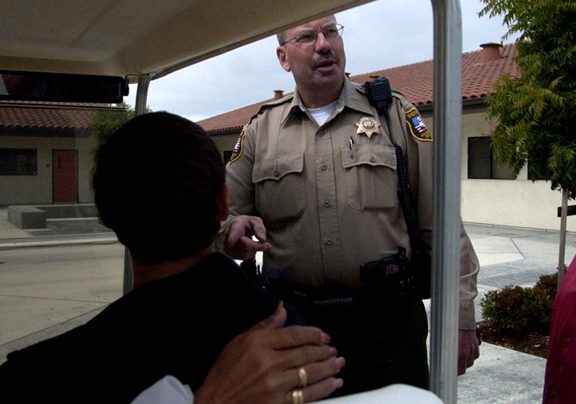Brown applies humor, compassion to keep schools safe in
Hollister
Dep. Rich Brown doesn’t come across as a softie. He’s imposing.
At over six feet tall and more than 200 pounds he looks like he
could go a few rounds with a bulldozer. He wears his military style
haircut short and clean, his moustache is well groomed and his
dress uniform is very neat. It’s a no-nonsense look, but a quick
conversation reveals his real nature.
Brown applies humor, compassion to keep schools safe in Hollister
Dep. Rich Brown doesn’t come across as a softie. He’s imposing. At over six feet tall and more than 200 pounds he looks like he could go a few rounds with a bulldozer. He wears his military style haircut short and clean, his moustache is well groomed and his dress uniform is very neat. It’s a no-nonsense look, but a quick conversation reveals his real nature.
Brown, San Benito County’s lone school resource officer, is particularly well-suited to his job. His imposing persona yields to a friendly tone, and a willingness to engage young people in conversations about themselves. He puts people at ease with his tone and definitive laugh, peppering conversations with corny jokes.
On a recent visit to Brown’s cramped office in the administration building at San Benito High, Brown was busy doing paperwork and checking voicemails. Before his day’s over he will detain an intoxicated student at San Benito High School and stay with that student until he is released to Child Protective Services.
The following day he will spend the duration of the day testifying in court for a case he was involved in.
Brown has a passion for working with kids, but he hasn’t always been a school resource officer. He started his law enforcement career in 1979 in Texas, in a community with fewer than 500 people. He has served in three branches of the military, including the National Guard where he was a Military Police officer. He was overseas in the Philippines during part of his military service. He served as a reserve officer with the Hollister Police Department where he was also the hostage negotiator and with the Los Gatos Police Department. He was the code enforcement officer for San Benito County for a spell.
For the last seven years, Brown has been with the sheriff’s department first in San Juan then in Hollister.
It was only two years ago that he took the job as the resource officer. As resource officer Brown works with students and administration from San Benito, Anzar and the two continuation schools in San Benito County to ensure that students are safe and protected within their school environment. Some of Brown’s responsibilities include working with the staff at the various schools to ensure students are safe and potential gang issues are contained. He also offers a willing ear to students whose past contacts with law enforcement officers may not have been positive.
“At the time nobody wanted the job,” Brown said. “I didn’t feel anybody would do well in the position if they were forced into it. I had some teaching experience on the [firing] range and with some various programs. I have also raised six kids and seven grandkids, so I know how to deal with kids.”
This has been one of the more difficult positions that Brown has had during his time in law enforcement, largely because he is constantly dealing with young people who don’t necessarily have a reason for the things that they do.
“They often don’t know why they did what they did,” Brown said. “There’s a portion of society called ‘gamers’ and the large chunk of high schoolers play video games. In playing video games there are no consequences, if you lose the game you simply reset or use devices to cheat. They translate these principals into their real lives. So, for example if they are driving and they go out of bounds and hit something there are real consequences, but they don’t understand that.”
The majority of the kids in the school district are good and stay out of trouble, Brown said. There are only a small percentage of the kids at the schools that Brown sees.
“I’d say 2 percent of the population [at the high school] give me 98 percent of the problems,” Brown said. Typically Brown would get involved with a situation if there is a crime involved. For example, if a student came to school intoxicated, Brown would be involved since that is a crime. However, he also assists with gang intervention and faculty training.
Many of the students he deals with continuously have problems staying out of trouble. They are gang members and people who are having problems at home, but they are also just kids, according to Brown.
Brown’s days are long. Typically he is at the high school by 7 a.m. and he works until 5 p.m. However there are days when he works later or has to make visits to student’s homes later in the evening. Earlier this month when a student was discovered at San Benito High School intoxicated, Brown was the first agent to respond. In addition to the campus supervisors and discipline administrators, Brown interviewed the student, tried to determine what that student was on and administered a breathalyzer test. Brown has a great working relationship with his peers. Though he’s based at the high school, the work he does for the sheriff’s department is felt elsewhere, according to Hill. In fact, in 2006, his peers selected him as the “Deputy of the Year” for the sheriff’s department.
“He is completely understanding of the needs of the community relative to the schools,” San Benito County Sheriff Curtis Hill said. “Rich is a huge asset not only for the sheriff’s department, but also for the schools as well.”
Hill said that Brown does a thorough job keeping the sheriff’s department up to date with all that happens within the schools, especially in relation to gang prevention.
“He’s proven that the work they do is important to the community and Rich is the epitome of an SRO,” Hill said. “He keeps me completely up to date.”
Because of Brown’s efforts, Hill said that the department is planning on hiring at least one, hopefully two, more full-time school resource officers during the next year.
But it is still a challenge getting students to understand that Brown is not at the school to arrest them, but as a resource.
“It’s different at the continuation schools, because many of the students there have previously had negative incidents with law enforcement,” Brown said.
Still even when he is at the continuation schools he has a rapport with the students. They approach him and joke around. They treat him like a friend.
At a recent graduation for Santa Ana continuation school Brown is approached several times throughout the day not just by friends, but also by people he has previously had to arrest. One even boasted that he hadn’t had an altercation with the law in five years.
It’s easy to see that he really likes the kids he works with.
“A few years ago, a kid who’d had some problems, ‘Tommy,’ thanked me when he graduated. He was having a tough time and now he’s fine,” Brown said. “The goal is to get as many kids as I can back on the right path.”
Kids on the border need extra support, Brown said.
Brown said he doesn’t get frustrated when he sees the same kids continue to make mistakes and bad choices.
When one approach doesn’t work with a student and they come back, he tries it another way.
“If A doesn’t work, I go to B. If B doesn’t work, I’ll try C,” Brown said. “It usually only takes three cracks before you find something that works. But I never give up.”
The only frustration is that there are not more people doing this job, Brown said.
“We need more people doing this. We need to address the issues now so that they are not problems later,” Brown said.
Once these kids turn 18, the consequences are more serious.
“The goal is to get kids on the right path before their 18th birthday,” Brown said. “Still, there are a lot of parents that don’t realize if their kid is still a student after they turn 18 they’re required to still look after them.”
Combating kids in gangs is somewhat of a frustration for Brown. Because when he sees these kids outside of that gang element, when they are away from the influences of their friends – in Brown’s office or with him away from the friends – he sees the kids in their purest.
“When they’re with their buddies it’s different,” Brown said. “Nobody can ever explain to me why they’re still in [gangs]. Nobody can tell why they stay in. Sometimes when I’m talking to these guys I joke with them and tell them to pretend for a minute that I’m a fairy godfather and I could grant them two wishes. The first thing most of these guys usually say is ‘I wish I’d never joined a gang.'”
The first year Brown started as a resource officer, he had a student that came to him really upset because he didn’t know how to tell his parents that he wanted to be a doctor. Both of his parents were in gangs and he didn’t know how to tell them he wanted something more.
The gut-wrenching part of the job is when Brown comes across a young person that is being abused. It’s easily the worst part of his job, because it’s hard to stomach.
Back at the graduation ceremony at Santa Ana, Brown gives out sheriff’s department stickers to some of the children present. He likes watching the kids grow up and is constantly shocked by how many kids he’s encountered that he’d met earlier in his career that are now grown.
“The most important thing is to try and not label kids, because once you do, you’re done,” Brown said.










